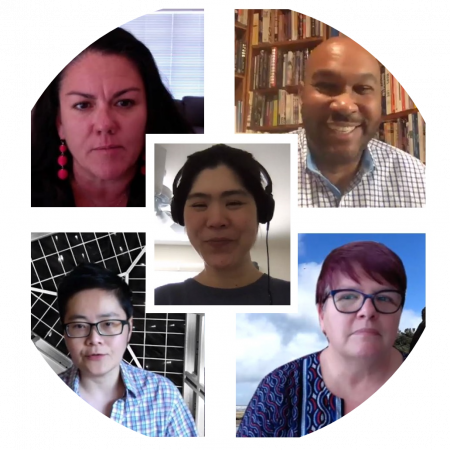Presentation: Digital Inclusion
Additional Resources: Digital Inclusion Checklist
Panelist: Jiatyan Chen, Robin Cole, Shelley Hou, Sheila Sanchez
Moderator: Eric Abrams
Recording of the session:
Central Questions:
- What is accessibility?
- What is the difference between accommodation and inclusion?
- When and where should inclusion be practiced?
- Why is digital inclusion important?
Key Quotes:
Accommodations are really individualized. When we think about events and activities, we want to make sure that people have an opportunity to request an accommodation that is going to meet their individualized needs. – Sheila Sanchez (11:37)
If anybody needs disability accommodations, please let us know. Having that invitation signals to somebody that this is something that the event organizers are aware of and something that they are going to be willing and able to assist with. – Shelley Hou (14:14)
The concept of inclusion, it’s not just people who need captioning or any kind of interpretation. There are people also using Zoom… So as we think about inclusion. Also, think about other technical difficulties as faced by the users. – Jiatyan Chen (14:44)
We should always be thinking about how we can create inclusive environments for everyone that we encounter. Accessibility should come first, the standard of accessibility is not the ceiling. That’s not what we’re trying to get to, that’s the least we should do. – Eric Abrams (25:12)
Make sure you’re including people with disabilities in your programming. So as you’re programming, are there people with disabilities seated at the table? Are there people within the GSE you have self identified as having a disability or are there allies within the community who are interested in making sure that disability is being thought about? – Sheila Sanchez (27:01)
One of the things that is super helpful is if you provide files in their original file format, whether that be Word or Powerpoint or whatever, as well as PDF… If the student has the file in the original file format, at least they can get access to the content. – Robin Cole (41:32)
Take-aways:
- Accessibility:
- The usability of a product, service, environment, or facility by people with the widest range of capabilities. — ISO 9241-20
- A person with a disability is afforded the opportunity to acquire the same information, engage in the same interactions, and enjoy the same services as a person without a disability in an equally effective and equally integrated manner, with substantially equivalent ease of use. — DOE OCR
- Accommodation vs. Inclusion
- Disability-related accommodations are required by law to ensure that people with disabilities have an equal opportunity to participate in programs and activities and to enjoy the same benefits and privileges as anyone else.
- Inclusion is a far bigger concept that includes involving and engaging with people with disabilities in all areas of life.
- Inclusion should always be practiced and accommodations should be made when identifiable or disclosed. Accessibility first is the standard – it’s the floor, not the ceiling.
- Inclusion should be practiced in all digital environments for: work, learning, events, communications, social media, campus life, research (e.g. Zoom meetings, class assignments, emails, etc.)
- Digital inclusion is important – it’s the right thing to do.
- Inclusion, IDEAL
- “At Stanford, we strive to ensure that a diversity of cultures, races and ethnicities, genders, political and religious beliefs, physical and learning differences, sexual orientations, and identities is thriving on our campus.” — Provost’s Diversity Statement
- Policy and Laws
- “Stanford University will make Stanford Websites and web‐based applications accessible to its students, faculty, staff, and participants in the University’s programs and activities who have disabilities.” — Stanford Online Accessibility Policy
- Americans with Disabilities Act (1990)
- Section 504 of the Rehabilitation Act (1973)
- Inclusion, IDEAL
